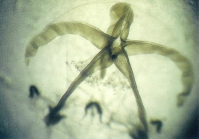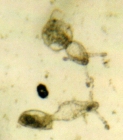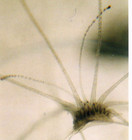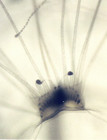WoRMS taxon details
Nemopsis bachei L. Agassiz, 1849
117348 (urn:lsid:marinespecies.org:taxname:117348)
accepted
Species
Bougainvillia charcoti Le Danois, 1913 · unaccepted (synonym)
Hippocrene cruciata Forbes & Goodsir, 1853 · unaccepted (incorrect spelling and synonym)
Hippocrene crucifera Forbes & Goodsir, 1853 · unaccepted (synonym)
Margelopsis gibbesii (McCrady, 1859) · unaccepted (invalid name, see remarks)
Nemopsis crucifera (Forbes & Goodsir, 1853) · unaccepted (synonym)
Nemopsis gibbesi McCrady, 1859 · unaccepted (synonym (medusa))
marine, brackish, terrestrial
recent only
Agassiz, L. (1849). On the Naked-eyed Medusae of the Shores of Massachusetts in their perfect state of development (Contributions to the Natural History of the Acalephae of North America Part 1. <em>Memoirs of the American Academy of Arts and Sciences (n. s.).</em> 4: 221-312, pls 1-8., available online at https://www.biodiversitylibrary.org/page/14226050
page(s): 289, fig. 1 [details]
page(s): 289, fig. 1 [details]
Type locality contained in Nantucket Sound
type locality contained in Nantucket Sound [details]
Distribution incudes Prince Edward Island (from the northern tip of Miscou Island, N.B. to Cape Breton Island south of Cheticamp,...
Distribution incudes Prince Edward Island (from the northern tip of Miscou Island, N.B. to Cape Breton Island south of Cheticamp, including the Northumberland Strait and Georges Bay to the Canso Strait causeway); Bay of Fundy [details]
Schuchert, P. (2024). World Hydrozoa Database. Nemopsis bachei L. Agassiz, 1849. Accessed through: World Register of Marine Species at: https://www.marinespecies.org/aphia.php?p=taxdetails&id=117348 on 2024-09-25
Date
action
by
![]() The webpage text is licensed under a Creative Commons Attribution 4.0 License
The webpage text is licensed under a Creative Commons Attribution 4.0 License
original description
Agassiz, L. (1849). On the Naked-eyed Medusae of the Shores of Massachusetts in their perfect state of development (Contributions to the Natural History of the Acalephae of North America Part 1. <em>Memoirs of the American Academy of Arts and Sciences (n. s.).</em> 4: 221-312, pls 1-8., available online at https://www.biodiversitylibrary.org/page/14226050
page(s): 289, fig. 1 [details]
original description (of Hippocrene cruciata Forbes & Goodsir, 1853) Forbes E., Goodsir J. (1853). On some remarkable marine Invertebrata new to the British Seas. <em>Transactions of the Royal Society of Edinburgh.</em> 20: 307-315., available online at https://www.biodiversitylibrary.org/page/40657151
page(s): Fig. 5a-e, in legend to figures, incorrect spelling [details]
original description (of Bougainvillia charcoti Le Danois, 1913) Le Danois, E. (1913). Note sur trois nouvelles méduses et liste des Coelentérés du plankton recueillis à bord du "Pourquoi-pas?" dans la croisière dans les mers du Nord. <em>Bulletin du Muséum National d'Histoire Naturelle, Paris.</em> 19: 110-113., available online at https://www.biodiversitylibrary.org/page/5051873
page(s): 111 [details]
original description (of Hippocrene crucifera Forbes & Goodsir, 1853) Forbes E., Goodsir J. (1853). On some remarkable marine Invertebrata new to the British Seas. <em>Transactions of the Royal Society of Edinburgh.</em> 20: 307-315., available online at https://www.biodiversitylibrary.org/page/40657151
page(s): 313 [details]
original description (of Nemopsis gibbesi McCrady, 1859) McCrady, J. 1859. Gymnopthalmata of Charleston Harbor. Proceedings of the Elliott Society of Natural History 1: 103-221, pls 8-12. , available online at https://www.biodiversitylibrary.org/page/42536587
page(s): 160, pl. 10, figs 1-3; note: [medusa only, not hydroid !] [details]
context source (Introduced species) Katsanevakis, S.; Bogucarskis, K.; Gatto, F.; Vandekerkhove, J.; Deriu, I.; Cardoso A.S. (2012). Building the European Alien Species Information Network (EASIN): a novel approach for the exploration of distributed alien species data. <em>BioInvasions Records.</em> 1: 235-245., available online at http://easin.jrc.ec.europa.eu [details] Available for editors [request]
[request]
context source (Schelde) Van Ryckegem, G.; Van Braeckel, A.; Elsen, R.; Speybroeck, J.; Vandevoorde, B.; Mertens, W.; Breine, J.; De Beukelaer, J.; De Regge, N.; Hessel, K.; Soors, J.; Terrie, T.; Van Lierop, F.; Van den Bergh, E. (2016). MONEOS – Geïntegreerd datarapport INBO: Toestand Zeeschelde 2015: monitoringsoverzicht en 1ste lijnsrapportage Geomorfologie, diversiteit Habitats en diversiteit Soorten. <em>Rapport van het Instituut voor Natuur- en Bosonderzoek, INBO.R.2016.12078839. Instituut voor Natuur- en Bosonderzoek: Brussel.</em> 178 pp. (look up in IMIS) [details]
basis of record van der Land, J.; Vervoort, W.; Cairns, S.D.; Schuchert, P. (2001). Hydrozoa, <B><I>in</I></B>: Costello, M.J. <i>et al.</i> (Ed.) (2001). <i>European register of marine species: a check-list of the marine species in Europe and a bibliography of guides to their identification. Collection Patrimoines Naturels,</i> 50: pp. 112-120 (look up in IMIS) [details]
additional source Bromley; Bleakney. (1977). [details]
additional source Brunel, P., L. Bosse & G. Lamarche. (1998). Catalogue of the marine invertebrates of the estuary and Gulf of St. Lawrence. <em>Canadian Special Publication of Fisheries and Aquatic Sciences, 126.</em> 405 pp. (look up in IMIS) [details] Available for editors [request]
[request]
additional source Calder, D. (2003). Checklist of Hydroids, hydromedusae and siphonophores reported from the Bay of Fundy. [details]
additional source Muller, Y. (2004). Faune et flore du littoral du Nord, du Pas-de-Calais et de la Belgique: inventaire. [Coastal fauna and flora of the Nord, Pas-de-Calais and Belgium: inventory]. <em>Commission Régionale de Biologie Région Nord Pas-de-Calais: France.</em> 307 pp., available online at http://www.vliz.be/imisdocs/publications/145561.pdf [details]
additional source Streftaris, N., A. Zenetos & E. Papathanassiou. (2005). Globalisation in marine ecosystems: the story of non-indigenous marine species across European seas. <em>Oceanogry and Marine Biology: an Annual Review.</em> 43: 419-453. (look up in IMIS) [details] Available for editors [request]
[request]
additional source Shih, C.T., 1977. A guide to the Jellyfish of Canadian Atlantic waters. National Museum of Natural Sciences, Natural History Series 5 : 1-190. [details]
additional source Integrated Taxonomic Information System (ITIS). , available online at http://www.itis.gov [details]
additional source Segura-Puertas, L., L. Celis, and L. Chiaverano. 2009. Medusozoans (Cnidaria: Cubozoa, Scyphozoa, and Hydrozoa) of the Gulf of Mexico, Pp. 369–379 in Felder, D.L. and D.K. Camp (eds.), Gulf of Mexico–Origins, Waters, and Biota. Biodiversity. Texas A&M Pre [details]
additional source Liu, J.Y. [Ruiyu] (ed.). (2008). Checklist of marine biota of China seas. <em>China Science Press.</em> 1267 pp. (look up in IMIS) [details] Available for editors [request]
[request]
redescription Schuchert, P. (2007). The European athecate hydroids and their medusae (Hydrozoa, Cnidaria): Filifera part 2. <em>Revue suisse de Zoologie.</em> 114: 195-396., available online at https://www.biodiversitylibrary.org/page/41281106
page(s): 235 [details]
page(s): 289, fig. 1 [details]
original description (of Hippocrene cruciata Forbes & Goodsir, 1853) Forbes E., Goodsir J. (1853). On some remarkable marine Invertebrata new to the British Seas. <em>Transactions of the Royal Society of Edinburgh.</em> 20: 307-315., available online at https://www.biodiversitylibrary.org/page/40657151
page(s): Fig. 5a-e, in legend to figures, incorrect spelling [details]
original description (of Bougainvillia charcoti Le Danois, 1913) Le Danois, E. (1913). Note sur trois nouvelles méduses et liste des Coelentérés du plankton recueillis à bord du "Pourquoi-pas?" dans la croisière dans les mers du Nord. <em>Bulletin du Muséum National d'Histoire Naturelle, Paris.</em> 19: 110-113., available online at https://www.biodiversitylibrary.org/page/5051873
page(s): 111 [details]
original description (of Hippocrene crucifera Forbes & Goodsir, 1853) Forbes E., Goodsir J. (1853). On some remarkable marine Invertebrata new to the British Seas. <em>Transactions of the Royal Society of Edinburgh.</em> 20: 307-315., available online at https://www.biodiversitylibrary.org/page/40657151
page(s): 313 [details]
original description (of Nemopsis gibbesi McCrady, 1859) McCrady, J. 1859. Gymnopthalmata of Charleston Harbor. Proceedings of the Elliott Society of Natural History 1: 103-221, pls 8-12. , available online at https://www.biodiversitylibrary.org/page/42536587
page(s): 160, pl. 10, figs 1-3; note: [medusa only, not hydroid !] [details]
context source (Introduced species) Katsanevakis, S.; Bogucarskis, K.; Gatto, F.; Vandekerkhove, J.; Deriu, I.; Cardoso A.S. (2012). Building the European Alien Species Information Network (EASIN): a novel approach for the exploration of distributed alien species data. <em>BioInvasions Records.</em> 1: 235-245., available online at http://easin.jrc.ec.europa.eu [details] Available for editors
context source (Schelde) Van Ryckegem, G.; Van Braeckel, A.; Elsen, R.; Speybroeck, J.; Vandevoorde, B.; Mertens, W.; Breine, J.; De Beukelaer, J.; De Regge, N.; Hessel, K.; Soors, J.; Terrie, T.; Van Lierop, F.; Van den Bergh, E. (2016). MONEOS – Geïntegreerd datarapport INBO: Toestand Zeeschelde 2015: monitoringsoverzicht en 1ste lijnsrapportage Geomorfologie, diversiteit Habitats en diversiteit Soorten. <em>Rapport van het Instituut voor Natuur- en Bosonderzoek, INBO.R.2016.12078839. Instituut voor Natuur- en Bosonderzoek: Brussel.</em> 178 pp. (look up in IMIS) [details]
basis of record van der Land, J.; Vervoort, W.; Cairns, S.D.; Schuchert, P. (2001). Hydrozoa, <B><I>in</I></B>: Costello, M.J. <i>et al.</i> (Ed.) (2001). <i>European register of marine species: a check-list of the marine species in Europe and a bibliography of guides to their identification. Collection Patrimoines Naturels,</i> 50: pp. 112-120 (look up in IMIS) [details]
additional source Bromley; Bleakney. (1977). [details]
additional source Brunel, P., L. Bosse & G. Lamarche. (1998). Catalogue of the marine invertebrates of the estuary and Gulf of St. Lawrence. <em>Canadian Special Publication of Fisheries and Aquatic Sciences, 126.</em> 405 pp. (look up in IMIS) [details] Available for editors
additional source Calder, D. (2003). Checklist of Hydroids, hydromedusae and siphonophores reported from the Bay of Fundy. [details]
additional source Muller, Y. (2004). Faune et flore du littoral du Nord, du Pas-de-Calais et de la Belgique: inventaire. [Coastal fauna and flora of the Nord, Pas-de-Calais and Belgium: inventory]. <em>Commission Régionale de Biologie Région Nord Pas-de-Calais: France.</em> 307 pp., available online at http://www.vliz.be/imisdocs/publications/145561.pdf [details]
additional source Streftaris, N., A. Zenetos & E. Papathanassiou. (2005). Globalisation in marine ecosystems: the story of non-indigenous marine species across European seas. <em>Oceanogry and Marine Biology: an Annual Review.</em> 43: 419-453. (look up in IMIS) [details] Available for editors
additional source Shih, C.T., 1977. A guide to the Jellyfish of Canadian Atlantic waters. National Museum of Natural Sciences, Natural History Series 5 : 1-190. [details]
additional source Integrated Taxonomic Information System (ITIS). , available online at http://www.itis.gov [details]
additional source Segura-Puertas, L., L. Celis, and L. Chiaverano. 2009. Medusozoans (Cnidaria: Cubozoa, Scyphozoa, and Hydrozoa) of the Gulf of Mexico, Pp. 369–379 in Felder, D.L. and D.K. Camp (eds.), Gulf of Mexico–Origins, Waters, and Biota. Biodiversity. Texas A&M Pre [details]
additional source Liu, J.Y. [Ruiyu] (ed.). (2008). Checklist of marine biota of China seas. <em>China Science Press.</em> 1267 pp. (look up in IMIS) [details] Available for editors
redescription Schuchert, P. (2007). The European athecate hydroids and their medusae (Hydrozoa, Cnidaria): Filifera part 2. <em>Revue suisse de Zoologie.</em> 114: 195-396., available online at https://www.biodiversitylibrary.org/page/41281106
page(s): 235 [details]
 Present
Present  Present in aphia/obis/gbif/idigbio
Present in aphia/obis/gbif/idigbio  Inaccurate
Inaccurate  Introduced: alien
Introduced: alien  Containing type locality
Containing type locality
From editor or global species database
Distribution incudes Prince Edward Island (from the northern tip of Miscou Island, N.B. to Cape Breton Island south of Cheticamp, including the Northumberland Strait and Georges Bay to the Canso Strait causeway); Bay of Fundy [details]Remark Hydroids are quite easy to obtain from medusa but they are very small, maximum 0.6 mm high. It makes it almost impossible to find them in nature. On September 13th 2002 I found five reduced hydroids on translucent plastic floating in the marina in Zeebruge. Medusa are present in Zeebrugge from half May until the end of October, sometimes in large quantities. The medusa typically have a pair of club-shaped tentacles in the middle of each tentacle bulbus. It was observed how the club-shaped tentacles developed from normal tentacles. A medusa of 2.5 mm was sampled, it had 4 long tentacles on each bulbus. The next day, the 2 middlemost tentacles contracted to form the club-shaped tentacles. A medusa of 3-4 mm has 6 tentacles, the middlemost already club-shaped, but still able to extend them for a reasonable length. Statistics of measurements in relation to the number of tentacles and branching of the stomach tentacles are made on 120 individuals. [details]
From regional or thematic species database
Introduced species vector dispersal in Belgian part of the North Sea: Ships: accidental as attached or free-living fouling organisms [details]Introduced species vector dispersal in Belgian part of the North Sea: Ships: accidental with ballast water, sea water systems, live wells or other deck basins [details]
Introduced species vector dispersal in Dutch part of the North Sea : Shipping [details]
Introduced species vector dispersal in Belgian part of the North Sea: Ships: accidental as attached or free-living fouling organisms [details]
Introduced species vector dispersal in Belgian part of the North Sea: Ships: accidental with ballast water, sea water systems, live wells or other deck basins [details]
Introduced species vector dispersal in Belgian part of the North Sea: Debris: transport of species on human generated debris [details]
Introduced species vector dispersal in Belgian part of the North Sea: Aquaculture: accidental [details]
From other sources
Alien species The hydroid Nemopsis bachei occurred naturally only along the Atlantic coast of North America. By attaching their polyps to hulls of ships; the species might have reached Europe in the 19th century. The jellyfish stage in the hydroids reproductive cycle allows it to spread rapidly. The species was first reported along the Belgian coast in 1996 in the port of Zeebrugge. [details]Biology colonial [details]
Dimensions umbrella up to 11 mm high [details]
Habitat upper epipelagic [details]
| Language | Name | |
|---|---|---|
| Dutch | Bache's knotsklokje | [details] |
| English | clinging jellyfishAmerican brackish water medusa | [details] |
| German | Amerikanische Brackwassermeduse | [details] |
To Barcode of Life (15 barcodes)
To Biodiversity Heritage Library (1 publication) (from synonym Bougainvillia charcoti Le Danois, 1913)
To Biodiversity Heritage Library (28 publications)
To Biodiversity Heritage Library (3 publications) (from synonym Nemopsis gibbesi McCrady, 1859)
To Biodiversity Heritage Library (4 publications) (from synonym Hippocrene crucifera Forbes & Goodsir, 1853)
To Biodiversity Heritage Library (5 publications) (from synonym Nemopsis crucifera (Forbes & Goodsir, 1853))
To Biodiversity Heritage Library (6 publications) (from synonym Margelopsis gibbesii (McCrady, 1859))
To European Nucleotide Archive, ENA (Nemopsis bachei)
To GenBank (87 nucleotides; 32 proteins)
To Information system on Aquatic Non-Indigenous and Cryptogenic Species (AquaNIS)
To Niet-inheemse soorten Belgisch deel Noordzee en aanpalende estuaria (in Dutch)
To PESI (from synonym Bougainvillia charcoti Le Danois, 1913)
To PESI
To PESI (from synonym Hippocrene crucifera Forbes & Goodsir, 1853)
To USNM Invertebrate Zoology Cnidaria Collection (245 records)
To ITIS
To Biodiversity Heritage Library (1 publication) (from synonym Bougainvillia charcoti Le Danois, 1913)
To Biodiversity Heritage Library (28 publications)
To Biodiversity Heritage Library (3 publications) (from synonym Nemopsis gibbesi McCrady, 1859)
To Biodiversity Heritage Library (4 publications) (from synonym Hippocrene crucifera Forbes & Goodsir, 1853)
To Biodiversity Heritage Library (5 publications) (from synonym Nemopsis crucifera (Forbes & Goodsir, 1853))
To Biodiversity Heritage Library (6 publications) (from synonym Margelopsis gibbesii (McCrady, 1859))
To European Nucleotide Archive, ENA (Nemopsis bachei)
To GenBank (87 nucleotides; 32 proteins)
To Information system on Aquatic Non-Indigenous and Cryptogenic Species (AquaNIS)
To Niet-inheemse soorten Belgisch deel Noordzee en aanpalende estuaria (in Dutch)
To PESI (from synonym Bougainvillia charcoti Le Danois, 1913)
To PESI
To PESI (from synonym Hippocrene crucifera Forbes & Goodsir, 1853)
To USNM Invertebrate Zoology Cnidaria Collection (245 records)
To ITIS







